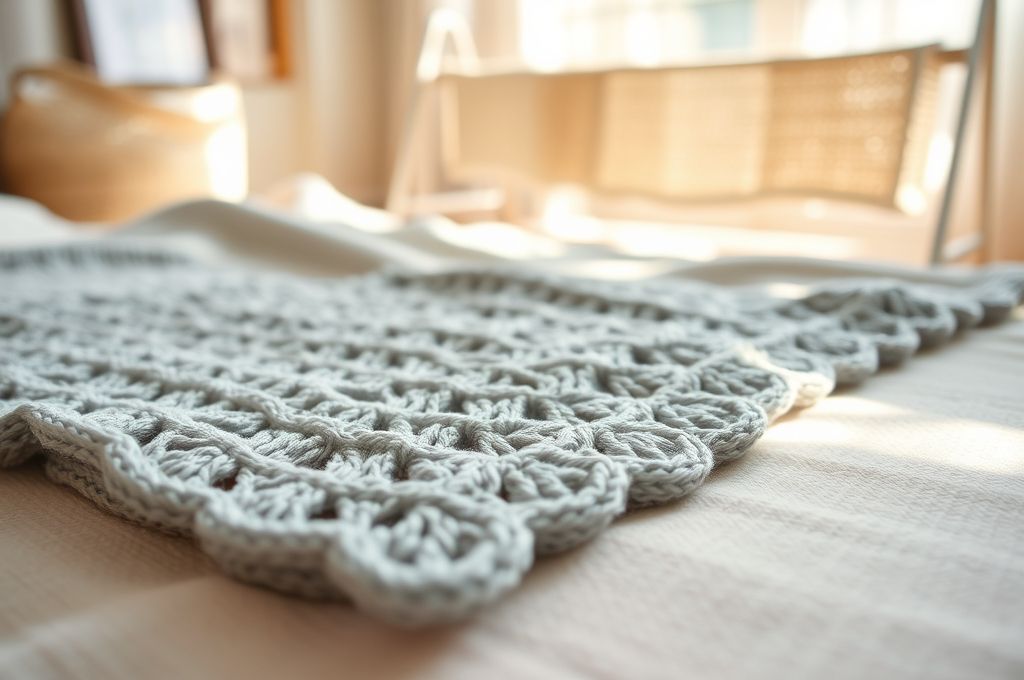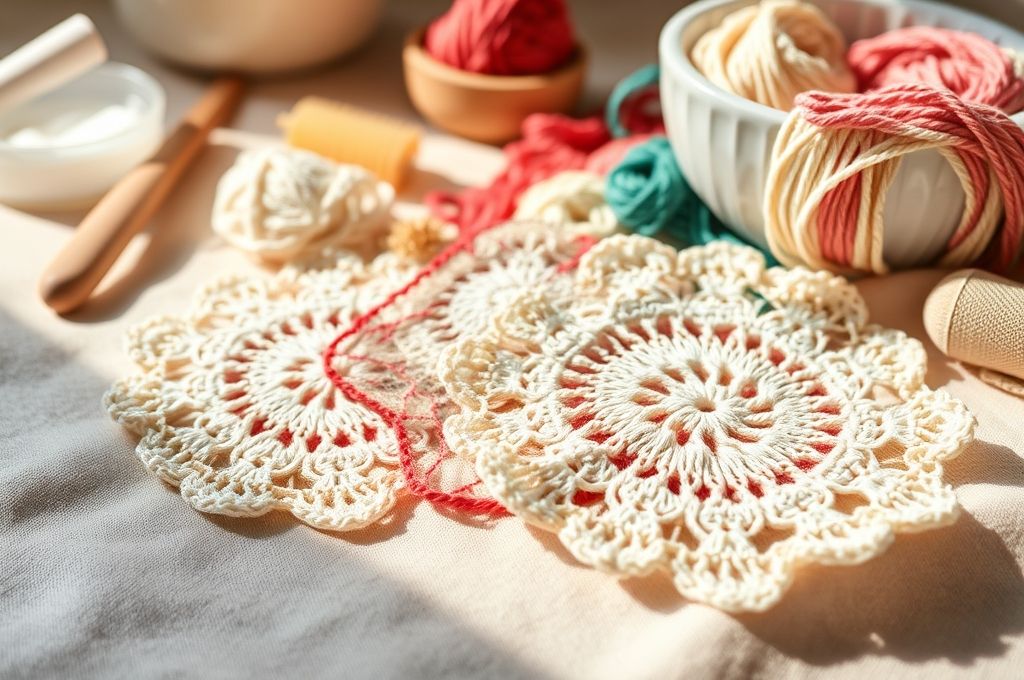More Than Just a Craft – It’s a Labor of Love
Have you ever spent hours—sometimes days—crocheting a cozy blanket, a delicate baby hat, or a vibrant market bag, only to feel a pang of anxiety when it’s time to clean it? You’re not alone. For crafters, each stitch tells a story. Every loop and knot holds a piece of your time, energy, and heart. That’s why knowing how to properly care for your crochet creations isn’t just about cleanliness—it’s about preserving memories, effort, and artistry.
Crochet items, whether handmade by you or gifted by someone special, deserve more than a toss into the washing machine. The wrong cleaning method can lead to stretched fibers, faded colors, or even irreversible damage. Yet, with the right knowledge, you can keep your pieces looking fresh, soft, and beautiful for years to come.
In this article, we’ll walk you through everything you need to know about washing and maintaining your crochet projects. From understanding fiber types to choosing the right detergent, from hand-washing techniques to proper drying and storage—we’ve got you covered. You’ll also learn how to spot potential problems before they happen and how to restore older pieces that have seen better days.
Whether you’re a seasoned crocheter or just starting out, this guide will help you treat your creations with the care they deserve. After all, these aren’t just textiles—they’re treasures. Let’s dive in and make sure they stay that way.
Know Your Fiber: The Foundation of Proper Care
Before you even think about water and soap, there’s one crucial step: identify the fiber your crochet piece is made from. Why? Because not all yarns are created equal. A wool sweater needs a completely different approach than a cotton dishcloth or an acrylic baby blanket. Treating them the same could mean disaster.
Let’s break it down:
- Natural fibers like wool, alpaca, cotton, and silk are breathable and often softer, but they’re also more delicate. Wool, for instance, can felt (shrink and mat together) if exposed to heat and agitation. Cotton is sturdy and machine-washable, but it can lose shape if not dried properly.
- Synthetic fibers like acrylic, nylon, and polyester are more resilient. They resist shrinking and are generally easier to care for, often surviving machine washing and drying. However, they can pill or become stiff over time if not treated gently.
- Blends (like cotton-acrylic or wool-nylon) combine the best of both worlds—but also require a balanced care approach. Always lean toward the more delicate fiber in the mix.
Pro Tip: Check your yarn label! Most commercial yarns come with washing symbols and care instructions. If you’re working with leftover yarn or a gift, take a moment to research the brand and fiber content online.
Understanding your fiber isn’t just about avoiding damage—it’s about respecting the material’s nature. Think of it like knowing your friend’s preferences: you wouldn’t serve spicy food to someone who can’t handle heat, right? The same goes for yarn. Treat it according to its personality, and it will thank you with longevity and beauty.
Hand-Washing: The Gold Standard for Delicate Pieces

When it comes to preserving the shape, texture, and color of your crochet creations, hand-washing is almost always the safest choice—especially for natural fibers and intricate designs. It may take a little more time, but the results are worth it.
Here’s a step-by-step guide to hand-washing your crochet items the right way:
- Fill a clean basin or sink with lukewarm water. Avoid hot water, which can cause shrinking or felting in wool and other animal fibers.
- Add a gentle detergent. Use a mild, pH-neutral soap designed for delicates or wool (like Woolite or Eucalan). Regular laundry detergent can be too harsh and strip natural oils from fibers.
- Submerge the item and gently press it down to let the water soak in. Don’t rub, twist, or wring—it can distort stitches and stretch the fabric.
- Let it soak for 10–15 minutes. This gives the water and soap time to loosen dirt and oils without damaging the fibers.
- Drain the soapy water and refill with clean, cool water to rinse. Repeat until the water runs clear.
- Remove excess water by gently squeezing (never wringing!). Lay the piece on a clean towel, roll it up, and press to absorb moisture.
- Reshape and dry flat on a fresh towel or drying rack, away from direct sunlight or heat sources.
This method is ideal for heirloom shawls, baby clothes, lace doilies, or anything with intricate stitch patterns. It’s also perfect for mixed-fiber projects or handmade gifts you want to keep looking pristine.
Bonus Tip: Add a splash of white vinegar to the final rinse to help remove soap residue and soften fibers naturally.
Hand-washing might seem like a chore, but it’s a form of mindfulness—a moment to reconnect with your creation and give it the attention it deserves.
When Machine Washing Is Safe (and When It’s Not)
Let’s be real—sometimes, you need convenience. Maybe you’ve crocheted a set of dishcloths, a child’s blanket, or a simple beanie that sees daily use. In these cases, machine washing can be a practical option, but only if done carefully.
When it’s safe:
- The yarn label says “machine washable.”
- The item is made from acrylic, cotton, or superwash wool.
- It has a simple, sturdy stitch pattern (like single or double crochet).
- It’s not embellished with buttons, beads, or delicate details.
How to machine wash safely:
- Use a gentle or delicate cycle with cold water.
- Place the item in a mesh laundry bag to reduce friction.
- Use a mild detergent—avoid bleach and fabric softeners.
- Never wash with heavy items like jeans or towels that can cause abrasion.
When to avoid machine washing:
- Wool, alpaca, or mohair (unless labeled superwash).
- Lace, doilies, or openwork patterns.
- Garments with shaping or seams.
- Anything with mixed fibers where one component is delicate.
Even if the yarn is machine-washable, consider hand-washing for the first few times to see how the piece holds up. Some items may soften beautifully, while others could lose their structure.
Real-life example: Sarah, a crochet enthusiast from Oregon, machine-washed her acrylic baby blanket weekly for six months with no issues. But when she tried the same with a wool hat, it shrank by half. Lesson learned: always check the fiber first.
The key is balance—use machines when appropriate, but never at the cost of your project’s integrity.
Drying Right: Why Flat Is the Way to Go

You’ve washed your crochet piece with care—now comes the next critical step: drying. This is where many well-intentioned crafters go wrong. Hanging a wet crochet garment to dry might seem logical, but it can lead to stretching, misshaping, or even permanent distortion.
Here’s why flat drying is essential:
Crochet fabric is flexible by design. When saturated with water, it becomes heavy. Gravity pulls on the fibers, especially in areas like shoulders, sleeves, or corners. Hang a sweater, and you might end up with a lopsided, elongated mess.
Best practices for drying:
- Lay the item on a clean, dry towel or a mesh drying rack.
- Gently reshape it to its original dimensions, smoothing out edges and corners.
- For garments, use measuring tape or a pattern template to ensure accuracy.
- Flip the piece halfway through drying to promote even air circulation.
- Keep it away from direct sunlight (to prevent fading) and heat sources (to avoid fiber damage).
For lace or doilies: Pin them into shape using rust-proof T-pins on a foam board or clean towel. This helps maintain intricate patterns and gives a crisp finish.
How long does it take? Depending on thickness and humidity, drying can take 24–48 hours. Be patient—rushing with a hairdryer or heater can cause fibers to become brittle.
Think of drying as the final stitch in your project. It’s not just about removing moisture; it’s about preserving the form and function of your work. A little extra time now can save you from heartbreak later.
Storage Solutions: Keep Your Creations Looking New
Once your crochet piece is clean and dry, how you store it matters just as much as how you wash it. Poor storage can lead to yellowing, moth damage, musty smells, or creases that are hard to remove.
Here are smart storage tips to protect your handmade treasures:
- Use breathable containers: Avoid plastic bins that trap moisture. Instead, opt for cotton storage bags, wooden chests, or cardboard boxes lined with acid-free tissue paper.
- Keep it clean: Never store a piece that’s dirty or slightly damp. Oils, sweat, and food residue attract pests and can cause permanent stains.
- Protect from moths: Natural fibers like wool are moth magnets. Use cedar blocks, lavender sachets, or airtight containers with bay leaves to deter insects—no harsh chemicals needed.
- Fold, don’t hang: As mentioned, hanging can stretch fibers. Fold larger items like blankets and sweaters, and place tissue paper between folds to prevent creasing.
- Rotate seasonal items: If you store winter scarves or holiday decor, bring them out occasionally to air them and check for damage.
- Label and organize: Keep a simple inventory of your handmade items, noting fiber content and care instructions. This makes future cleaning easier.
Storytime: Maria from Texas stored her grandmother’s crocheted tablecloth in a plastic bag for 20 years. When she finally pulled it out, it was yellowed and brittle. A gentle wash and sun-fading helped, but some damage was irreversible. Now, she stores all her heirlooms in cotton pillowcases with lavender—simple, effective, and respectful.
Proper storage isn’t just practical—it’s an act of love. You’re not just saving space; you’re safeguarding memories.
Dealing with Stains and Spills: Quick Action Saves the Day
Accidents happen. A drop of coffee on a crochet coaster. A crayon mark on a child’s blanket. A grass stain on a market bag. The good news? Most stains can be treated successfully—if you act fast.
General stain removal tips:
- Blot, don’t rub: Rubbing can push the stain deeper into the fibers.
- Treat immediately: The sooner you address a stain, the better your chances of removing it.
- Test first: Always test cleaning solutions on an inconspicuous area.
Common stains and solutions:
- Food or drink: Rinse with cold water, then soak in mild soapy water. For coffee or wine, a drop of hydrogen peroxide (on white or colorfast items) can help.
- Oil or grease: Sprinkle cornstarch or baking soda to absorb, wait 15 minutes, then brush off and wash.
- Ink: Dab with rubbing alcohol using a cotton swab—carefully, to avoid spreading.
- Crayon or wax: Place the item between paper towels and iron on low heat to lift the wax, then wash.
For delicate items, avoid harsh chemicals. A mixture of dish soap and water often works wonders.
When in doubt, consult a professional. For valuable heirlooms or stubborn stains, a textile conservator or dry cleaner experienced with handcrafts may be worth the investment.
Remember: panic won’t help, but prompt, gentle action will. Your crochet piece is tougher than you think.
Reviving Old or Damaged Pieces: Give Them a Second Life
Not every crochet creation stays in perfect condition. Over time, items can become yellowed, stiff, or slightly misshapen. But that doesn’t mean they’re beyond saving.
Here’s how to breathe new life into older pieces:
- Yellowed whites? Soak in a mixture of cold water and oxygen-based bleach (like OxiClean) for a few hours. Avoid chlorine bleach, which weakens fibers.
- Stiff or crunchy? Wash with a small amount of hair conditioner or wool wash to restore softness.
- Misshapen? Wet block it. Wash the item, then reshape and pin it to dry as described earlier. This can work wonders for lace or garments that have lost their form.
- Faded colors? While you can’t restore color, you can refresh the look by pairing the item with complementary fabrics or repurposing it into something new—like turning an old sweater into pillow covers.
Creative revival ideas:
- Turn a worn blanket into a quilt of squares.
- Use vintage doilies as wall art or table runners.
- Crochet over damaged areas with contrasting yarn for a “visible mending” look—popular in sustainable fashion.
Reviving old pieces isn’t just about aesthetics; it’s about sustainability and emotional connection. Every repair tells a new chapter in the story.
Prevention: The Best Maintenance Strategy
As the saying goes, “An ounce of prevention is worth a pound of cure.” The same applies to crochet care.
Simple habits to protect your creations:
- Rotate usage: Don’t wear the same crochet sweater every day. Let fibers rest and recover.
- Use liners: Wear a cotton layer under crochet garments to reduce sweat and oil transfer.
- Spot clean when possible: For small stains, a quick wipe with a damp cloth may be enough—no full wash needed.
- Store with care: As discussed, proper storage prevents 90% of long-term damage.
- Follow yarn labels: They’re your first line of defense.
Also, consider the environment where your items live. High humidity can lead to mildew; dry heat can make fibers brittle. A closet with moderate temperature and airflow is ideal.
By building these small habits into your routine, you’ll spend less time fixing problems and more time enjoying your creations.
Final Thoughts: Cherish Every Stitch
Caring for your crochet creations goes far beyond laundry instructions. It’s about honoring the time, creativity, and love poured into every loop and chain. These pieces aren’t just functional—they’re personal. They warm your body, decorate your home, and often carry emotional weight.
When you wash, dry, and store them with care, you’re not just maintaining fabric. You’re preserving memories. A baby blanket that once swaddled a newborn. A scarf gifted to a friend during a hard time. A table runner made for a holiday gathering. These are the threads that weave through our lives.
So the next time you hold a crochet piece in your hands, take a moment to appreciate it. Feel the texture, admire the pattern, and remember the hands that made it—yours or someone else’s. Then, treat it with the kindness it deserves.
Conclusion: Care Is an Act of Love
We’ve covered a lot—from understanding fiber types to mastering hand-washing, from proper drying to smart storage and stain removal. But the heart of this article isn’t just about techniques. It’s about respect. Respect for the craft, the materials, and the effort behind every handmade item.
By following these care tips, you’re not only extending the life of your crochet projects—you’re honoring the artistry in them. You’re saying, “This matters.”
So go ahead: wash that blanket with care. Store that shawl with love. Rescue that stained coaster instead of tossing it. Small actions make a big difference.
And if you’re feeling inspired, why not try crocheting something new—knowing you now have the tools to keep it beautiful for years to come?
Now we’d love to hear from you: What’s your favorite crochet piece, and how do you care for it? Share your stories, tips, or questions in the comments below. Let’s build a community that celebrates and preserves the handmade world—one stitch at a time.

Daniele Ferreira is passionate about the world of crochet, dedicating her time to exploring techniques, creating unique pieces, and sharing her knowledge with beginners and aficionados alike. With attention to detail and creativity, she transforms yarn into true works of art, inspiring others to discover the beauty and joy of this manual art.







